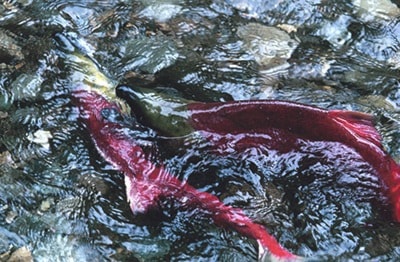It’s late summer in the Bering Sea, where chum salmon are living, avoiding danger and finding food, when something inside of them snaps. It’s an instinctual trigger they can’t ignore, leading them back to the place of their birth and soon, their death.
“They’ve been spending their life out in the ocean for three to four years, sometimes five, growing to be big adult salmon, defeating all the odds against them,” naturalist and manager of the Goldstream Nature House, Tracey Bleackley explains. “Once that trigger has gone off they stop eating and they’re just swimming. They’re just heading here.”
Goldstream River is one of the last on Vancouver Island to have its salmon run, primarily because of its southern location. For tourists and residents alike, however, it’s one of the most accessible and well-known spots to see this cycle of nature in action, drawing thousands of people.
After the journey south, achieved through scent, sight and a natural ability to find magnetic north, the salmon make their way up the river when the temperature drops, the rain increases and leaves start dropping from the trees.
The females begin to swim against the current of the river as they search for the exact spot they were born. They can get within a metre of their own birthplace, using scent to pinpoint the location.
Females dig holes in which to lay their eggs as the males fight one another for fertilization rights. The female sinks into her nest and leaves her eggs, at which point the dominant male has just 15 seconds to fertilize them. Both the male and female fish, having laid and fertilized all the eggs they can, die.
It’s this spectacle which causes the parking lot of Goldstream Park to spill over to the sides of the Trans-Canada Highway every autumn.
It’s far from the end, though. What park staff refer to as “the clean up crew” begins its work. Multiple species of birds an d mammals, including hundreds of eagles, some bears and wolves, make their way to the river to feast on the dead fish.
Long after the scavengers have left, as the sun moves closer to our part of the world and the waters of Goldstream River begin to warm up in the early days of spring, the labours of the prior fall begin to pay off. The eggs begin to hatch, first into alevin, and then into fry, thousands of them, wiggling their way out of the gravel to begin their trip to the open ocean, ready to face a dangerous life in the hopes of starting the entire process over again.
By Kyle Wells
arts@mondaymag.com
